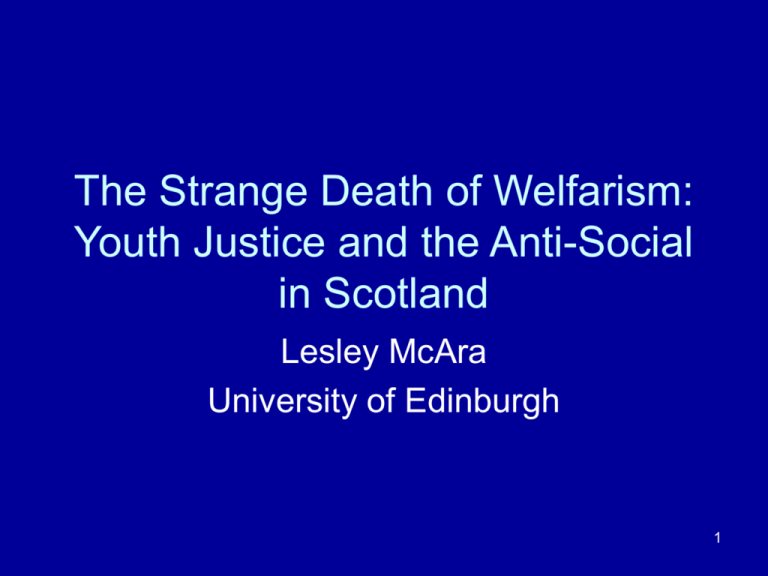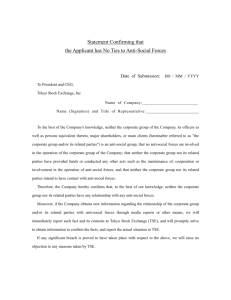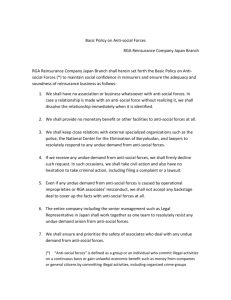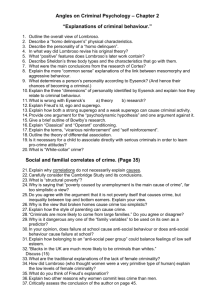Lesley McAra - School of Law
advertisement

The Strange Death of Welfarism: Youth Justice and the Anti-Social in Scotland Lesley McAra University of Edinburgh 1 Key lessons from the Scottish case • Political questions - Highlights the political risks of ‘governing through crime’ • Methodological questions - Highlights the need for scholars to look beyond policy documents to practice: a critical pluralist approach • Normative questions - Highlights the moral vacuum at the heart of punitive and exclusionary approaches 2 Political lessons 3 1970s Scotland England/ Wales Full flowering welfarism Retreat from welfarism 1980s Punishment and systems management Early-mid 1990s “The darkness” Late 1990s000s •Increased managerialism; •Public protection, risk management, effective practice; •Social inclusion, crime prevention, communities as stakeholders; •Individual rights and responsibilisation; •Restorative justice, victims as stakeholders. 4 Anti-social behaviour legislation: a potted history • 1998 Crime and Disorder Act - ASBOs introduced for 16+ (applied for by LAs to Sheriff court, police to be consulted) • 2003 The Criminal Justice (Scotland) Act - Interim ASBOs introduced - RSL enabled to apply for ASBOs • 2004 Anti-Social Behaviour etc. (Scotland) Act - Extends use of ASBOs to 12 – 15 year olds - Police powers to disperse groups - Community reparation orders (via courts for those aged 12+) - Extension of remote electronic monitoring (tagging) to under 16s; - Parenting orders 5 Differences from England/Wales (12-15 year olds) • Reporter to children’s hearings system to be consulted before an ASBO may be applied for • Sheriff to take account of “what is happening to the child in the hearings system and the best interests of the child” • The making of an ASBO or interim ASBO should be a trigger for a children’s hearing and court can require Reporter to arrange a hearing • Breach is criminal offence but “will not lead to imprisonment where no other offences are involved” 6 Community Family Child 7 Parent(s) of Offender Offender Community Victim 8 A moral panic? • Statements by Ministers - Youth crime and anti-social behaviour is a complex and serious problem across Scotland. However, one thing is clear – our communities have had enough of it. (Scottish Executive 2002) - Serious crime is down but as today’s statistics show, communities are clearly still plagued by vandalism and other persistent forms of antisocial behaviour. (Scottish Executive 2004) • Media headlines (focus on ‘ned culture’) - Extra police target ned culture (BBC News, February 2004) - Crackdown on 'neds' will require extra £12m (Scotland on Sunday, June 2004) - Nike the Ned downed 60 bacardis and went on wrecking spree (Daily Record, May 2004) - Friday night out with the superneds (Sunday Herald, June 2003) 9 Police recorded crime/offences in Scotland (1988-2007) Source: Scottish Government 2000000 1800000 1600000 1400000 1200000 1000000 800000 600000 400000 200000 0 19 88 19 90 19 92 19 94 19 19 20 20 20 20 96 98 00 02 04 06 /9 /9 /0 /0 /0 /0 7 9 1 3 5 7 10 Scottish crime survey :% very or fairly worried that they will be victim Source: Brown and Bolling 2007 70 60 50 Housebreaking Sexual assault Mugged/robbed Assault Vandalism to home 40 30 20 10 0 1993 1996 2000 2002 2005 11 19 92 19 93 19 94 19 19 95 96 19 /97 97 19 /98 98 19 /99 99 20 /00 00 20 /01 01 20 /02 02 20 /03 03 20 /04 04 20 /05 05 20 /06 06 /0 7 % population Offence referrals to children’s hearing system Source: SCRA 2008 5 4.5 4 3.5 3 2.5 2 1.5 1 0.5 0 12 Scottish Household Survey: Neighbourhood Incivilities (very or fairly common problem) (Source: Scottish Government 2008) Young people hanging around Drunks/druggies Vandalism/graffiti 19 99 20 00 20 01 20 02 20 03 20 04 20 05 20 06 20 07 50 45 40 35 30 25 20 15 10 5 0 13 Scottish Social Attitudes Survey: youth incivilities very or fairly common and how much affected by (Source: Anderson et al. 2005) 70 60 50 40 Very/fairly common Affected a great deal 30 20 10 0 Groups hanging around Vandalism, graffiti Young people drinking Young drug users 14 Public attitudes towards youth crime (Source: Scottish Social Attitudes Survey : Anderson et al. 2005) Is level youth crime same/ higher/lower as 10 years ago? Higher % 69 Lower 2 Same 25 15 Methodological lessons 16 A failure of implementation? By March 2008: • 0 parenting orders • 14 ASBOs for under 16s (£500,000 each!) • 18 dispersal orders • 93 electronic taggings of under 16s (0.2% of children referred on offence grounds) 17 Normative lessons 18 Edinburgh Study of Youth Transitions and Crime ‘Anti-social’ vs. non-offenders (hang out most days, noisy and cheeky in public, involved in vandalism and graffiti) (www.law.ed.ac.uk/cls/esytc) Victimization (mean) Adult harassment (mean) 3 0.5 2.5 0.4 2 Boys 1.5 Girls 1 0.3 Boys 0.2 Girls 0.1 0.5 0 0 Non-offenders Non-offenders Anti-social Sexual intercourse age 14 or under % Self-harm % 35 30 25 20 15 10 5 0 Anti-social 40 Boys Girls 30 20 Boys 10 Girls 0 Non-offenders Anti-social Non-offenders Anti-social 19 Edinburgh Study of Youth Transitions and Crime ‘Anti-social’ vs. non-offenders (cont.) School exclusion % Major family crisis in past year % 20 60 50 15 40 30 Boys 20 Girls Boys 10 Girls 5 10 0 0 Non-offenders Anti-social Non-offenders Anti-social Neighbourhood deprivation (mean) Free school meal entitlement % 25 4 20 3 15 Boys 10 Boys 2 Girls Girls 1 5 0 0 Non-offenders Anti-social Non-offenders Anti-social 20 Housing policies Job security legislation Neighbourhood Family policies Hours of work School Father Dwelling Child care policies Child health centre medical care Child Mother Parents’ work situation Labour market policies Friends Siblings TV/mass media Leisure time Social security Cultural policies Communal support of voluntary agencies and leisure activities 21 Bronfenbrenner/Martens (1993)






